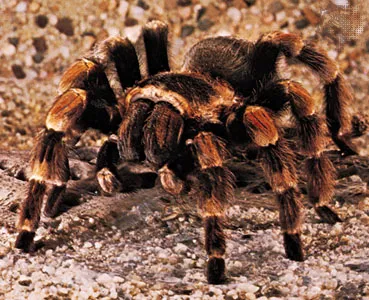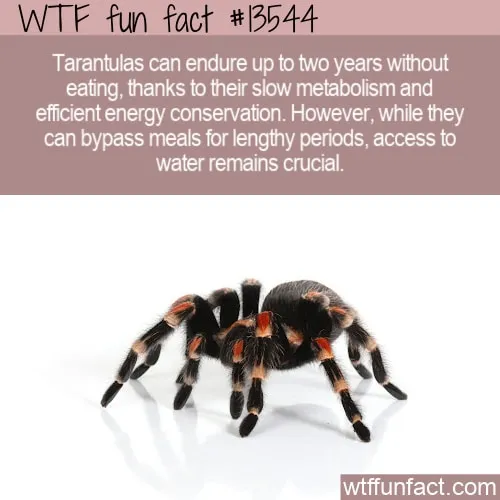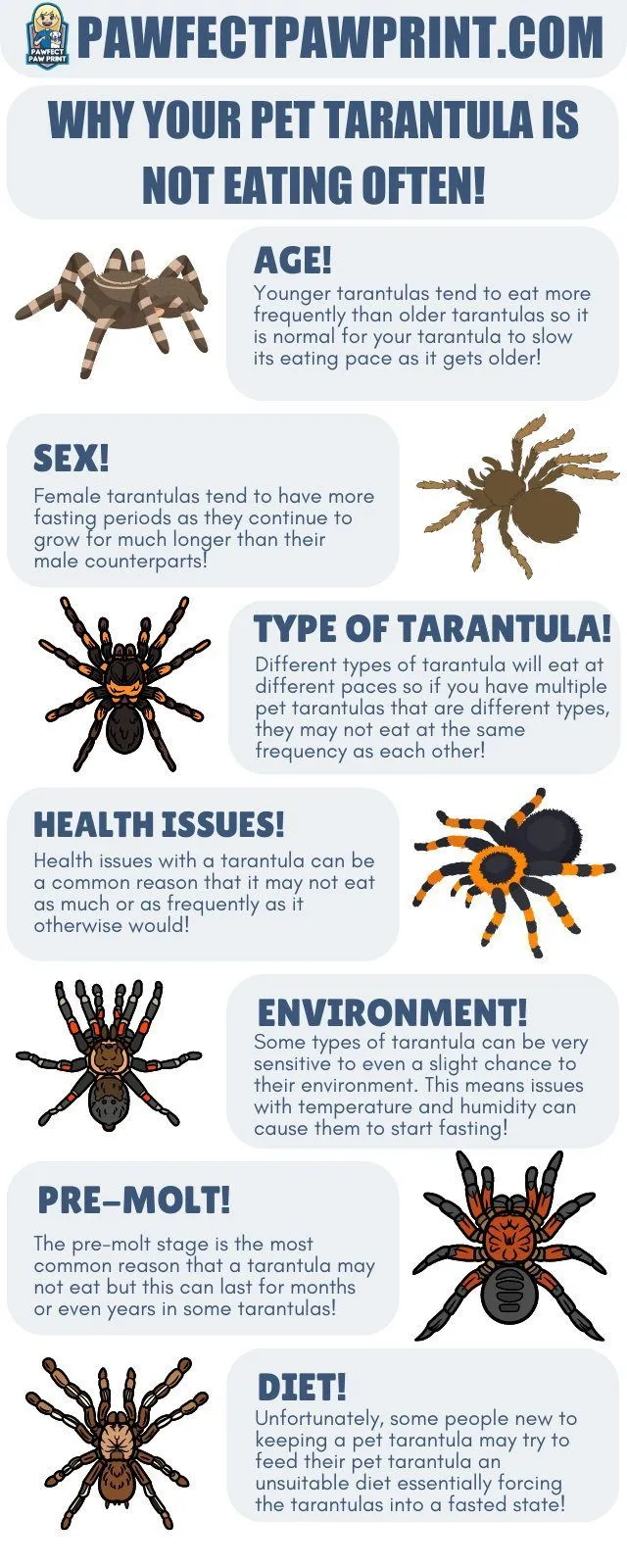The Remarkable Resilience of Tarantulas
Tarantulas, fascinating creatures of the arachnid world, have captivated humans for centuries. Their unique appearance and intriguing behaviors make them popular pets for many. One aspect of tarantula life that often raises questions is their ability to survive without food. Unlike many other pets, tarantulas are built for periods of fasting, a survival mechanism honed over millennia. This resilience is a key part of understanding their care and ensuring their well-being. This article will explore the top 5 facts regarding tarantula fasting, offering insights into their incredible ability to thrive even when meals are scarce. Understanding these facts is essential for any tarantula owner, providing valuable knowledge to ensure the health and happiness of these remarkable creatures.
Fact 1 Tarantulas Can Endure Extended Fasts
One of the most astonishing facts about tarantulas is their capacity to endure long periods without food. In the wild, they often face inconsistent food availability, especially during certain seasons or in harsh environments. Consequently, they have evolved to store energy and slow their metabolism to conserve resources. Healthy adult tarantulas can often go for weeks, even months, without eating, depending on various factors. This ability is partly due to their ectothermic nature, meaning their body temperature is regulated by their environment, thus impacting their metabolic rate. When the temperature drops, so does their need for food, making them even more efficient at conserving energy. This remarkable adaptation is a testament to their resilience and survival skills.
Factors Influencing Fasting Duration

Several factors influence how long a tarantula can survive without food. These include the tarantula’s metabolic rate, influenced by its species and environmental conditions, its size and age, and the temperature and humidity of its enclosure. Understanding these factors is crucial for responsible tarantula care and for recognizing when a tarantula may be facing a health concern. By monitoring these elements, you can better assess your tarantula’s well-being and ensure it receives the proper care. Moreover, knowing the impact of these factors helps in making informed decisions regarding feeding schedules and environmental adjustments, particularly when dealing with juvenile tarantulas or during periods of brumation.
Metabolic Rate and Species
Different tarantula species have varying metabolic rates, affecting their ability to go without food. Some species, particularly those from arid environments, have evolved to be more efficient at conserving energy and can endure longer fasting periods. Others, with faster metabolisms, may require more frequent feeding. The size of the tarantula plays a huge role. For instance, fast-growing species may have a higher metabolic rate and need more frequent meals. Understanding your specific tarantula species and its natural habitat is crucial for providing appropriate care. Researching their native environment can help you mimic those conditions in their enclosure, which will also influence their feeding needs and overall health.
Size and Age of the Tarantula
The size and age of a tarantula also greatly impact its fasting capabilities. Juvenile tarantulas, being in a rapid growth phase, generally require more frequent feeding compared to adults. Their metabolic rate is higher, and they need more energy to molt and grow. Adult tarantulas, on the other hand, can typically endure longer periods without food. This is because their growth rate slows down significantly, and they have already built up sufficient energy reserves. As a tarantula ages, its metabolism may also change, requiring adjustments to its feeding schedule. Always remember to adjust your feeding practices based on the stage of life of your tarantula, carefully monitoring its body condition and activity levels to ensure it remains healthy.
Environmental Conditions

Environmental conditions, particularly temperature and humidity, significantly influence a tarantula’s fasting duration. Tarantulas are ectothermic, meaning their body temperature is largely determined by their surroundings. When the enclosure’s temperature drops, the tarantula’s metabolism slows down, and it requires less food. Conversely, higher temperatures can increase their metabolic rate, necessitating more frequent feeding. Humidity also plays a role, as it affects their ability to stay hydrated. Maintaining optimal environmental conditions is crucial, especially during periods of fasting. Proper temperature and humidity levels contribute to their overall health and ability to endure periods without food, reflecting their adaptability and the importance of providing an environment that mimics their natural habitat.
Fact 2 Prolonged Fasting is Common
Prolonged fasting is a normal behavior for tarantulas, especially during certain phases of their lives or environmental conditions. It is not always a sign of illness or distress. Many tarantulas will fast before molting, a process during which they shed their exoskeletons to grow. During this time, they may lose their appetite and become less active. It is important to be aware of these natural cycles to understand your tarantula’s behavior. A tarantula’s refusal to eat doesn’t always mean there is something wrong. It is vital to provide proper care while they are fasting, ensuring that they have access to water and a stable environment, allowing them to go through natural cycles such as molting and periods of rest.
Understanding Brumation and Estivation
Brumation and estivation are natural survival mechanisms that involve periods of inactivity and reduced metabolic rates in response to environmental changes. Brumation typically occurs in cooler months, mimicking hibernation in other animals, while estivation is triggered by hot and dry conditions. During these periods, tarantulas may reduce their feeding frequency or stop eating altogether. Providing a suitable environment that aligns with their natural cycles is crucial. This includes adjusting temperature and humidity levels. During these periods, it’s important to be patient and allow your tarantula to follow its natural instincts. Ensure proper water and a stable environment, understanding that this behavior is a normal part of their life cycle.
Fact 3 Health and Hydration are Key

While tarantulas can go without food for extended periods, maintaining their health and hydration is paramount. Even during fasting, it’s critical to ensure the tarantula has access to fresh, clean water and the right humidity levels for its species. Dehydration can quickly lead to serious health problems, regardless of whether they’re eating or not. Adequate hydration supports the tarantula’s bodily functions and helps it to endure the fasting period more effectively. Monitoring the water dish and adjusting humidity levels as needed is an important part of their care. Proper hydration helps them molt, regulates their metabolism, and is important for their overall health and resilience during fasting.
Providing Water
Providing a clean water source is essential, especially during fasting. A shallow water dish, accessible to the tarantula, should always be available. The water should be changed regularly to prevent the growth of bacteria or mold. Some tarantula keepers use water crystals, which are another way to provide moisture while minimizing the risk of drowning. Regularly misting the enclosure can help maintain the necessary humidity, but make sure to avoid soaking the substrate, as this can cause problems. These simple steps will help keep your tarantula hydrated and healthy, especially during prolonged fasting periods, reflecting the importance of basic needs for these resilient creatures.
Maintaining Proper Humidity
Maintaining the right humidity level is critical, as it directly impacts the tarantula’s ability to stay hydrated. The ideal humidity level varies depending on the species. Tropical tarantulas require higher humidity levels than desert species. Using a hygrometer will allow you to monitor the humidity levels and adjust as necessary. Misting the enclosure periodically, particularly the substrate, is a common method for increasing humidity. Poor humidity can lead to dehydration and hinder molting, stressing the tarantula. Monitoring and adjusting the humidity levels based on the species will improve the health and well-being, particularly when dealing with fasting periods, and help the tarantula survive.
Fact 4 Signs of a Healthy Tarantula

Observing your tarantula’s behavior is critical to assess its health and well-being. A healthy tarantula will typically be active, move around its enclosure, and have a robust appearance. The abdomen should be plump, not shriveled, which can indicate dehydration. While a tarantula may refuse food for extended periods, it’s crucial to monitor for other signs of illness. Lack of coordination, lethargy, or unusual posture could be signs of health problems. If you notice any concerning signs, consult with an experienced tarantula keeper or a veterinarian familiar with exotic animals. Regularly observing your pet’s behavior is a fundamental part of responsible tarantula care, helping you to identify and address potential health concerns.
Fact 5 Reintroducing Food Safely
When a tarantula resumes eating after a fasting period, reintroducing food gradually is important. Start by offering small, easily digestible prey items, such as small crickets or mealworms. Avoid overfeeding the tarantula immediately after a fast, as its digestive system may need time to adjust. Slowly increase the size and frequency of feedings as the tarantula’s appetite returns. Always observe the tarantula’s response to the food. Watch for a good feeding response, and then monitor for any signs of digestive distress. By taking a patient and cautious approach, you can help your tarantula get back into a healthy feeding routine. Make sure that you provide fresh prey, suitable for your tarantula’s size, and offer them only when the tarantula is ready.
Conclusion
Tarantulas’ ability to go without food is an impressive adaptation, and understanding these facts is vital for responsible pet ownership. It is not a sign of problems when your tarantula refuses food, but is often normal behavior. By understanding the factors influencing fasting duration, paying attention to hydration, and observing their behaviors, you can ensure your tarantula thrives. Remember to provide clean water, maintain proper humidity, and gradually reintroduce food after a fasting period. These simple practices will help these amazing creatures live long and healthy lives. Owning a tarantula is a rewarding experience, and by understanding their needs, you can provide them with the best possible care.
